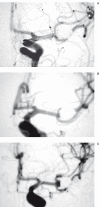New Devices Designed to Improve the Long-Term Results of Endovascular Treatment of Intracranial Aneurysms. A Proposition for a Randomized Clinical Trial to Assess their Safety and Efficacy
- PMID: 20587221
- PMCID: PMC3464448
- DOI: 10.1177/159101990401000201
New Devices Designed to Improve the Long-Term Results of Endovascular Treatment of Intracranial Aneurysms. A Proposition for a Randomized Clinical Trial to Assess their Safety and Efficacy
Abstract
Endovascular coiling can improve the outcome of patients with ruptured intracranial aneurysms, but angiographic recurrences are frequent compared to surgical clipping. New coils or devices have been introduced to improve long-term results of endovascular treatment but none have been the object of a valid clinical trial. We have proposed a multicentric randomized double-blind study comparing radioactive and standard coil occlusion of aneurysms. The purpose of this article is to review issues that are specific to the design of clinical trials to assess embolic agents that could improve the long-term efficacy of endovascular treatment of intracranial aneurysms. The proposed trial is a randomized, multi-center, prospective, controlled trial comparing the new generation coils to standard platinum coils. Blinding, if at all possible, is preferable to minimize bias, at least for follow-up angiographic studies that should cover a period of 18 months. All patients with an intracranial aneurysm eligible for endovascular treatment would be proposed to participate. The study would enrol approximately 500 patients equally divided between the two groups, recruited within two years, to demonstrate a decrease in the recurrence rate, the primary outcome measure, from 20% to 10%. Secondary outcome measures should assure that complications, initial clinical and angiographic results remain unchanged. Independent data safety and monitoring committees are crucial to the credibility of trials and to ensure scientific rigor and objectivity. The scientific demonstration of an improved long-term efficacy, without significant compromise regarding safety, is mandatory before considering the widespread use of a new embolic device for the endovascular treatment of aneurysms.
Figures
Similar articles
-
New generation Hydrogel Endovascular Aneurysm Treatment Trial (HEAT): a study protocol for a multicenter randomized controlled trial.Neuroradiology. 2018 Oct;60(10):1075-1084. doi: 10.1007/s00234-018-2074-5. Epub 2018 Aug 17. Neuroradiology. 2018. PMID: 30120516
-
Bare platinum coils vs. HydroCoil in the treatment of unruptured intracranial aneurysms-A single center randomized controlled study.Eur J Radiol. 2015 Feb;84(2):261-5. doi: 10.1016/j.ejrad.2014.11.002. Epub 2014 Nov 13. Eur J Radiol. 2015. PMID: 25480678 Clinical Trial.
-
Second-Generation Hydrogel Coils for the Endovascular Treatment of Intracranial Aneurysms: A Randomized Controlled Trial.Stroke. 2018 Mar;49(3):667-674. doi: 10.1161/STROKEAHA.117.018707. Epub 2018 Feb 6. Stroke. 2018. PMID: 29437981 Free PMC article. Clinical Trial.
-
Ruptured carotid-ophthalmic aneurysm treatment: a non-inferiority meta-analysis comparing endovascular coiling and surgical clipping.Br J Neurosurg. 2017 Jun;31(3):345-349. doi: 10.1080/02688697.2017.1297371. Epub 2017 Mar 2. Br J Neurosurg. 2017. PMID: 28637115 Review.
-
Microsurgical clipping and endovascular coiling of intracranial aneurysms: a critical review of the literature.Neurosurgery. 2008 Jun;62(6):1187-202; discussion 1202-3. doi: 10.1227/01.neu.0000333291.67362.0b. Neurosurgery. 2008. PMID: 18824986 Review.
Cited by
-
Interventional neuroradiology: the role of experimental models in scientific progress.AJNR Am J Neuroradiol. 2007 Mar;28(3):401-5. AJNR Am J Neuroradiol. 2007. PMID: 17353303 Free PMC article. Review.
-
ICONE: An International Consortium of Neuro Endovascular Centres.Interv Neuroradiol. 2008 Jun 30;14(2):203-8. doi: 10.1177/159101990801400213. Epub 2008 Jun 30. Interv Neuroradiol. 2008. PMID: 20557763 Free PMC article.
-
Scales, agreement, outcome measures, and progress in aneurysm therapy.AJNR Am J Neuroradiol. 2007 Mar;28(3):501-2. AJNR Am J Neuroradiol. 2007. PMID: 17353322 Free PMC article. Review. No abstract available.
References
-
- Guglielmi G, Viñuela F, et al. Electrothrombosis of saccular aneurysms via endovascular approach. Part 2: Preliminary clinical experience. J Neurosurg. 1991;75:8–14. - PubMed
-
- Raymond J, Roy D. Safety and efficacy of endovascular treatment of acutely ruptured aneurysms. Neurosurgery. 1997;41:1235–1245. discussion 1245-1236. - PubMed
-
- Molyneux A, Kerr R, et al. International subarachnoid aneurysm trial (isat) of neurosurgical clipping versus endovascular coiling in 2143 patients with ruptured intracranial aneurysms: A randomised trial. Lancet. 2002;360:1267–1274. - PubMed
-
- Raymond J, Roy D, et al. Endovascular treatment of acutely ruptured and unruptured aneurysms of the basilar bifurcation. J Neurosurg. 1997;86:211–219. - PubMed
LinkOut - more resources
Full Text Sources


